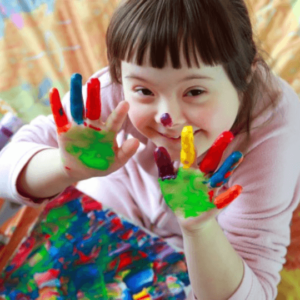 Making art with children is a fun and rewarding experience for both the child and the adult. Creating and sharing the experience can be valuable time spent with a child. Sometimes, however, there can be a disconnect where the emphasis is on the end result of the art project, not on the experience and process. Art that is focused on the end result, and not on the process of getting there or the act of expressing the creative mind is called product art. Product art does not focus on the emotional component or individual expression. For children, this can easily turn them away from wanting to create more art in the future.
Making art with children is a fun and rewarding experience for both the child and the adult. Creating and sharing the experience can be valuable time spent with a child. Sometimes, however, there can be a disconnect where the emphasis is on the end result of the art project, not on the experience and process. Art that is focused on the end result, and not on the process of getting there or the act of expressing the creative mind is called product art. Product art does not focus on the emotional component or individual expression. For children, this can easily turn them away from wanting to create more art in the future.
The opposite of product art is called process art. What is process art? Process art is art that allows the child to make the decisions from start to finish. The emphasis is more on the journey than on the destination. Process art let’s the child take the reins in creating the project, from choosing the design materials and techniques, to deciding what the art will be of. It encourages communication between children and adults, as well as helps children make art how they want to and on what they want to. When the child takes control of the idea and implementation of the art, the art that is created is a real expression of the child. When you think of art, you might think of expressing emotion. Process art helps the child to achieve that without focusing on having something made to a specification.
So why is it important that we emphasize process art over product art in early childhood development? For starters, process art encourages children to interact with their peers to overcome any challenges that may arise. Children can develop language and communication skills by sharing about their project as well. It also emphasizes that the child can make decisions regarding the activity, and in doing so, empowers them to be more creative. Process art supports social-emotional health. Empowering young children to believe in themselves and support their feelings and decisions is such an important concept. Process art supports cognitive development through problem-solving and decision making and helps children work on fine motor skills such as cutting, folding and gluing. It can make the experience fun by not setting strict guidelines of what should be created and how. This helps make art, and self-expression as a result, a joyful experience that is to be encouraged and appreciated.
The next time you sit down to do an art project with children, try implementing a process art based activity. Let the children decide what they want to make, and how they want to go about it. Encourage them to use their imagination, and support their decisions to use any materials they want. Watch the way that they use their minds and their imagination, and celebrate their creative expression while supporting their development.
To see more process art projects or to find some activities that help promote positive early childhood development, check out our Pinterest page. If you are interested in working with children as a certified family child care provider, learn more on our Certification page.
